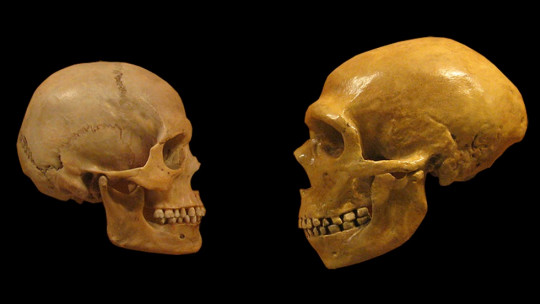
Most living beings are designed to react to what happens to them in the present, so their survival requires a perceptual process that is oriented towards the immediate.
Learning, the result of direct experience and the years of evolution of each of the species (phylogeny), is responsible for forging this capacity, necessary for the continuity of the individual and his group.
The human being, however, has the ability to abstract objective reality and give it its own meaning, through the mechanism of symbolization. Through this we create, imagine and communicate with each other; as we explore what is hidden behind the curtain of appearances.
In this article we will talk about human symbolic thought despite the fact that there has recently been significant controversy regarding the possibility that other species may have it.
What is symbolic thinking
Symbolic thinking is the ability of a living being to think beyond the situation in which it is present, thereby generating abstract mental contents on which it projects its representation capacity. In human beings it has been described that, under normative development conditions, this ability begins at 18 months of age (coinciding with Jean Piaget’s preoperational phase).
According to Piaget, in this stage (which includes the period between two and seven years) the child begins to understand the role of others and his own, to create symbols in order to represent tangible objects and to draw the relationships that exist. between them could occur.
However, the logical foundation to create cause and effect patterns at a non-immediate level would still be lacking, so your brain will have to continue maturing to the next stage to achieve this (formal operations).
Through symbolic thinking we can talk about what happened in the past or what we hypothesize will happen in the future, evoking memories and developing hypotheses respectively. Thus, we are able to move beyond what the senses capture, revealing a universe whose fabric is embroidered by the intangible.
Symbolic thinking in humans
Below we proceed to detail some of the expressions of symbolic thought, necessary to understand the human being in its entirety. Language, culture, play, drawing (or painting) and mathematics will be taken into account.
1. Written and oral expression: language
The use of words is a basic example of symbolization, since the verbal keys with which we describe reality are not at all what they indicate, but rather their translation into abstract and consensual terms. Thus, when you read a book you mentally access the scenarios described in its pages, but although there is the ability to clearly imagine each of its passages, at no time are we physically present in them.
In addition to reading, symbolic thinking participates decisively in writing. Every universe that is captured on paper has been, first of all, created in the mind of whoever stops it with their hand.
Through the written word and the use of letters, which symbolically represent the sounds of speech (and these in turn the real objects to which they refer), a process of abstraction is configured for which this type of thinking is required. The meaning of letters and sounds is arbitrary, and is only granted by social consensus
What has been outlined is applicable to the understanding of objects, but through language it is also possible to symbolize attributes or other intangible aspects, such as justice or kindness (which have an obvious cultural component). In this sense, fables describe stories that contain learning about issues relevant to life according to the historical moment (moralizing purpose), and are part of traditions that are transmitted intergenerationally.
2. Culture and society
The culture to which an individual belongs is based on the human being’s capacity for symbolization. It is estimated that the cognitive revolution, from which we were able to build knowledge that did not depend on the immediate, happened at some point in the past (between 30,000 and 70,000 years ago). The first known representation is an ivory carving with a human body and lion’s head found in Stadel (Germany), which is considered pioneering evidence of our ability to imagine (and create) something that does not exist.
When human groups were small in size, with tribes of just a few dozen individuals, it was easy to have knowledge about those who were part of them and their corresponding relationships. The human ability to think abstractly allowed social networks to expand thereby creating large communities that would require novel methods to survive (such as livestock and agriculture).
It is not known exactly how it could have occurred, but the hypothesis of a genetic mutation in homo sapiens is postulated, which led to cortical development (neocortex) of sufficient magnitude for the formation of thoughts and abstract concepts that allowed life in a community. In order to unite ties between such a large number of subjects sharing a common space, stories and laws were developed about abstract realities that gave a greater sense of belonging. And from this, the great cities of today.
Culture is subject to a series of norms and traditions that are learned without the need for direct experience with them. To do this, popular wisdom, the legal framework, myths and stereotypes are used; which are the cause of certain groups having more rights and/or duties (due to lineage or other non-objectifiable achievements). All of them are products of symbolic thinking, and obvious examples of how this can condition the destiny of human beings.
3. Symbolic game
Symbolic play is very important for the development of early social relationships, and an unavoidable opportunity to practice the uses and customs of the society in which one lives. That is why children frequently resort to such recreational activities, in which they act by reproducing the roles of the adults with whom they live daily. It is one of the mechanisms through which society maintains its symbols, and even toys are designed for this purpose.
In symbolic play, jobs are represented or one pretends to be all types of characters, often requiring the participation of at least two children. Properties are also attributed to inanimate objects (a box can become a mobile phone, for example), which requires cognitive resources such as analogy (equating two different objects through their shared properties, such as their shape or size). ) and abstraction.
This way of playing involves training symbolic thinking, which is especially located in the frontal lobe, and allows the development of social skills necessary to successfully interact with the environment.
4. Drawing and painting
In Borneo (Indonesia) there is the oldest sample of cave painting known today, dating back to the year 38,000 BC. Although these are generally human handprints printed on the walls, there are also everyday scenes of hunting and certain symbols whose meaning is unknown. These findings, beyond their undeniable relevance as artistic pieces, contribute to inferring at what moment in history we began to think through abstractions.
And it is that The drawing is a graphic representation of realities which, very often, are not present at the time of being captured. Drawing or color served so that different societies transmitted a seal of identity and could record what their distinctive characteristics were, extending their legacy far beyond their physical survival (which often ended after periods of great famine, extermination or disease). pandemics). A very recent example is found in flags.
In current times, drawing continues to be used to represent ideas located only in the mind of the one who executes them An architect, for example, uses his knowledge of physics and design to transfer to paper the idea he has had about a new building or other type of structure. And since this had never been built before (it is not a mere reproduction), it is a symbolic and abstract exercise that requires higher cognitive processes.
The same can be said of modern works of art, many of which do not reflect reality, but rather symbolic abstractions of it.
5. Mathematics
Mathematics is a universal language. Although in their elementary forms they refer to a simple matter of degree or proportion, deep knowledge of them requires an enormous level of abstraction (through which we can understand the tacit relationships observed in nature). It is because of that Mathematics is present in many sciences, such as physics or computer science
Some mathematical operations cannot even be inferred from experience with reality. This is common in theoretical physics, which depends on the integration of knowledge about formulas and theories with the purpose of deducing hypotheses about how the universe works, without having the opportunity to observe them with one’s own eyes. Through it we go deeper, from symbolization, where the naked senses do not reach.








